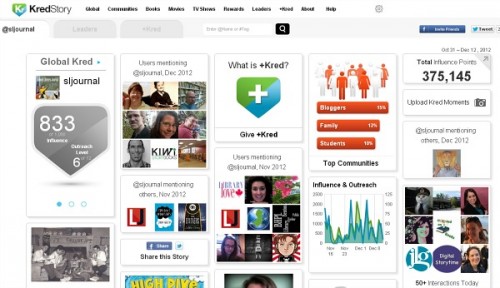
Not all information tasks are the same. And because sources that may be perfect for analyzing Hamlet’s motivation, may not be right for examining what’s happening now in Damascus or how far down we might fall from the fiscal cliff, learners need new credibility assessment strategies.
As teachers and librarians we are used to discussing traditional measures of credibility with student researchers. We want learners to recognize those brand name authors, journals, and databases that represent authority for a particular field of knowledge, those sources that add immediate gravitas to the works cited list. We want them to annotate those sources and look for evidence of the authority of the content creators.
Scholars and journalists let you know about their credentials. Serious bloggers generally do that, too. But creators of social media and members of networked communities don’t always have CVs.
So what strategies can we share for analyzing the credibility of social media and user-generated content?
There are a few newer metrics. And while they may not be perfect measures of authority in brand-driven, perhaps self-indulgent landscapes, student researchers ought to know about their existence as potential tools.
On a basic level, students can Google the content creator, to see what else they have produced and if their search leads to their profiles and discussion. They can peek at profiles and content on Facebook, RebelMouse, or Pinterest.
They can search and examine numbers of followers or friends or fans or likes. They can evaluate the currency and relevance of network contributions.
They can also examine social influence scores.
Social influence scores are not generally aimed at student researchers. They are not perfect measures of authority. Businesses and brands spend a lot of time and effort managing and marketing their social influence. And those folks tend to be a bit competitive about their rankings, looking at them as a brand influence leader boards.
But when students examine new media, these measures function as assessment tools as well as tools for discovery. Finding one leader in an area of knowledge will lead you to others.
Here’s a list of four of the more popular analyzers of social influence.
(Note: Because I self-indulgently used myself as a guinea pig, no colleagues or friends were harmed in this experiment.)
1. Kred Story. New to the field, Kred Story presents a real-time visual history of social media analytics, not only for people, but for hashtags, books, movies, television, and communities.
Twitter- and Facebook-centric, Kred displays a beautiful and sometimes overwhelming chart of areas of influence and outreach, sharing 1200 days of social media dialog–posts, images, videos, links–on one page. It’s kinda reminiscent of Pinterest or RebleMouse.
Unlike many of the other players in this field, Kred offers a retrospective scale on the right side of the page, allowing users to zoom in on a time period to see difficult-to-find historical tweets. Demonstrating an unusual level of transparency, Kred Story allows you to click on the metric of Total Influence Points to see exactly how those Influence and Outreach points are calculated–numbers of retweets, replies, mentions, etc. Kred also offers a peek into a number of Communities.
Continue reading…


